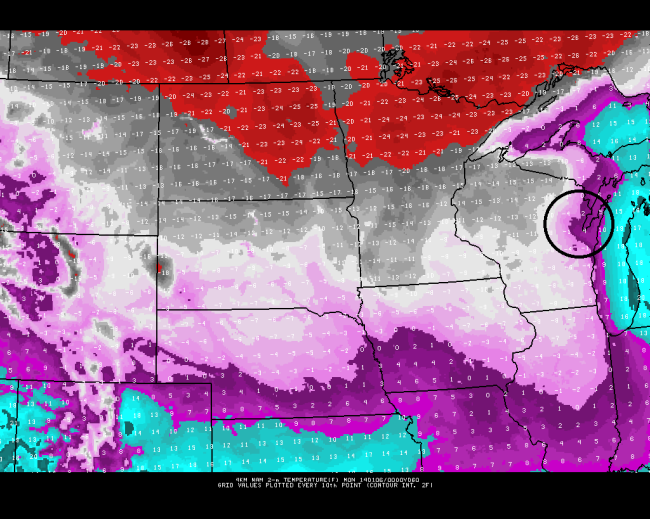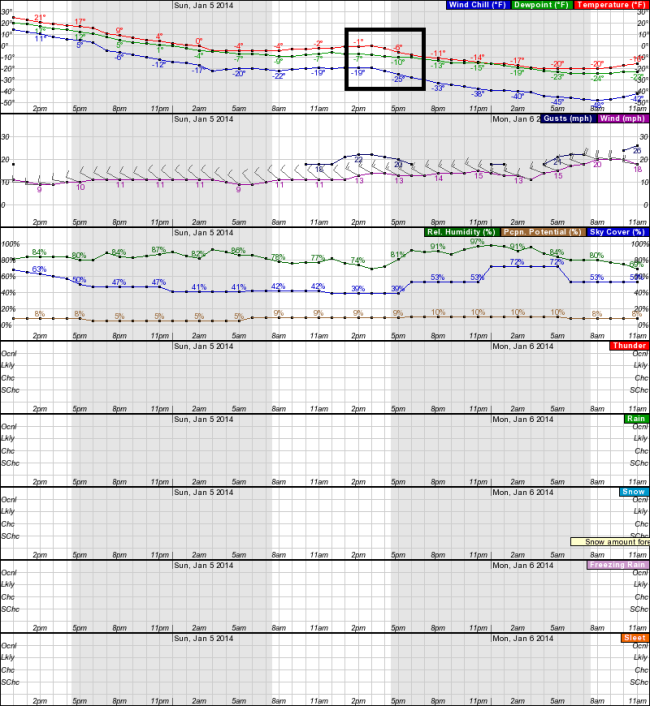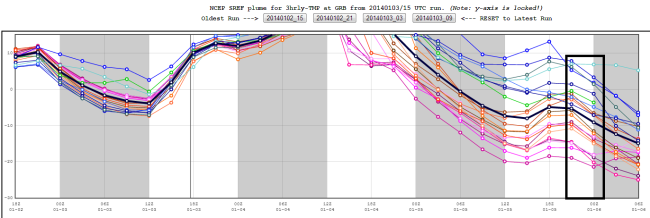Sensationalism reigns supreme in today’s 24/7 news cycle world. If you aren’t the loudest or boldest, why even bother, right?
Today’s Drudge Report has a headline reading:
Bleacher Report agrees: http://bleacherreport.com/articles/1909338-packers-49ers-playoff-game-might-be-coldest-nfl-game-ever
The San Francisco Chronicle concurs also: http://blog.sfgate.com/stew/2014/01/02/49ers-playoff-game-in-green-bay-could-be-coldest-ever/
There’s no question that Sunday’s Packers/Niners game is going to be painfully, brutally cold, and it will most likely crack the list of 10 coldest games in NFL history.
According to NFL.com, the coldest game in history was the Ice Bowl on December 31, 1967, also at Lambeau of course, with a temperature of -13°. The second coldest was 1/10/82 at Cincinnati between the Bengals and the Chargers, with temperature of -9°. And #3 all-time was Chiefs/Colts in Kansas City on 1/7/96, with a temperature of -6°.
So for it to be the coldest ever, it would need to be -13° during the game. For it to crack the top three, we’d need to have a temp of -6° during the game. Can we do it? Let’s examine the evidence.
The game is scheduled to kick off at 3:40 PM local time. Weather models and data are frequently in Greenwich Mean Time or Zulu (Z) time. Accordingly, this game is slated to kick off at 21:40Z. Assuming an average NFL games lasts roughly 3 hours, we’ll examine temperatures in the 21Z to 00Z timeframe.
First off, the bane of most weather forecasters is MOS (model output statistics). It takes weather models, applies statistical algorithms, and produces a temperature, precip, cloud cover, etc. forecast based on the model and history. Sometimes it works nicely, but a lot of times it can be less than stellar. Anyway, looking at the two primary models’ MOS forecasts from this morning:
I have highlighted the key times. The GFS model (top) is showing temperatures falling from -6° to -10° during the game. The NAM model however disagrees substantially and is quite a bit warmer, with temperatures dropping from +6° to +2° during the game. Worth noting: If you look at the far right numbers (-25° top and -21° bottom), that indicates the the models are only four degrees apart for the Monday morning low temperature in Green Bay. So the issue is timing. The GFS is faster bringing in the Polar cold to Green Bay than the NAM model, which is a few hours slower.
A higher-resolution version of the NAM model is run also. It goes out 60 hours (vs. 84 hours like the normal resolution version the MOS output is derived from). Looking at that from the PSU E-Wall:
The map above is for 00z (or right around the end of the game). It shows temperatures just approaching 0° west of Green Bay (I circled the Green Bay area). So add another to the slower/”milder” camp. Incidentally, the European model (considered the gold standard of weather models) is somewhat between these two, with temps dropping to somewhere in the -2° to -5° range during the game.
The National Weather Service forecast office in Green Bay is on the colder side of things. Their forecast is below. They have temps falling to -6° to -8° or so, with wind chills of -25°.
And the last thing I will show you is what the SREF, or short-range ensemble forecast spread in temperatures is for Sunday afternoon. This is a suite of a bunch of short-range models, all with different parameters to create a cluster or consensus forecast.
The black line in the “middle” represents the mean of the various models averaged together. That mean forecast is for temps to drop from roughly -6° to -9° during the game. Note that leading into the gametime period, it does appear the model consensus splits into two camps…a milder one and a cold straight through one. The bigger cluster heading into the game window appears to be near the mean or just milder. So the mean is probably a fair representation of this model.
So, with all this being said, will Sunday’s Packers/Niners Wild Card matchup be the coldest NFL game in history? Most likely not. However, there is at least a reasonably small chance it could be if things come together perfectly. The GFS model does tend to rush certain air masses and weather systems, so I would be apt to lean warmer than it, but colder than the NAM model. This would put me at something like -3° to -1° at kickoff and maybe -7° to -5° at the end of regulation.
Either way, it should be a memorably cold game that’s something of a throwback or relic to old school football.





